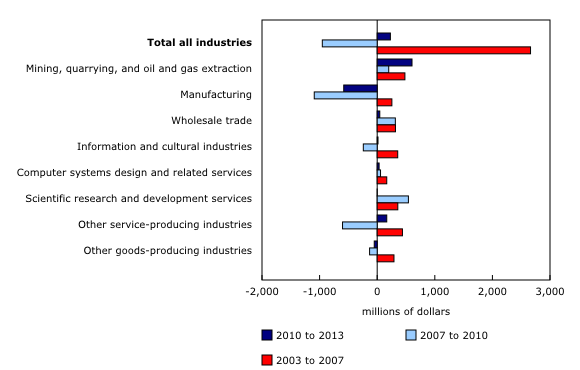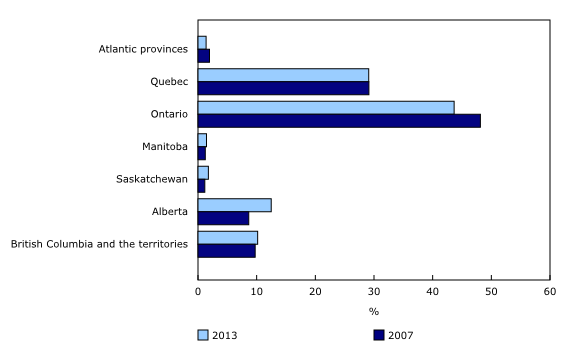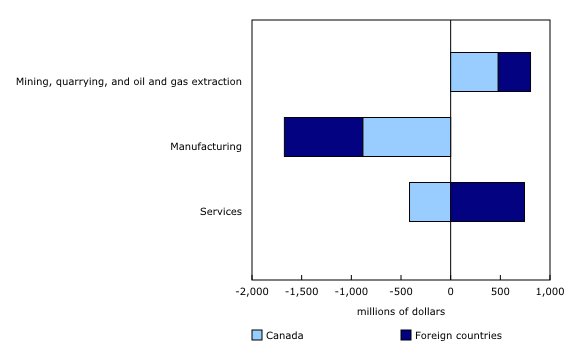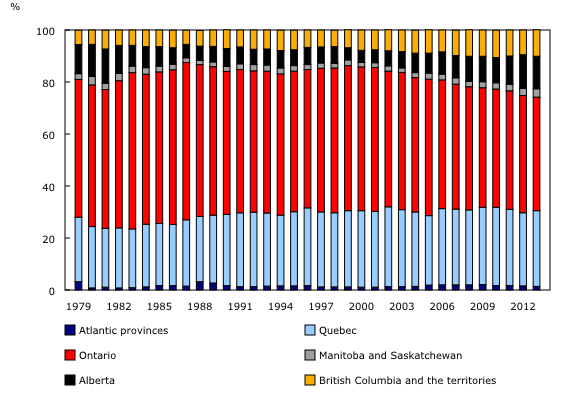Study: Industrial contributions to research and development spending in Canada
Archived Content
Information identified as archived is provided for reference, research or recordkeeping purposes. It is not subject to the Government of Canada Web Standards and has not been altered or updated since it was archived. Please "contact us" to request a format other than those available.
Released: 2017-02-15
Businesses in Canada spent $16.0 billion on in-house research and development (R&D) in 2013, compared with $14.1 billion a decade earlier. However, business sector R&D in 2013 was below pre-recession levels, as the pace of spending in different R&D-performing industries changed significantly after the 2008–2009 recession.
Annual in-house spending on industrial R&D by businesses in 2013, measured in current dollars, was about $700 million lower than it was in 2007, as reduced spending by Ontario-based manufacturers was partly offset by higher R&D spending in Alberta's energy sector. From 2007 to 2013, the overall number of R&D personnel employed by businesses in Canada declined 21.1%, reflecting fewer technicians and technologists working in R&D-performing manufacturing and service firms.
From 2007 to 2013, Canada's ratio of business enterprise expenditure on research and development (BERD) to gross domestic product (GDP) fell from 1.06% to 0.85%. In contrast, the overall BERD-to-GDP ratio for countries that are part of the Organisation for Economic Co-operation and Development rose from 1.53% to 1.61% during the same period.
Lower R&D spending by manufacturers after the 2008–2009 recession
Prior to the 2008–2009 recession, support for higher spending on industrial R&D came from a range of economic sectors. In-house R&D spending by businesses rose from $14.1 billion in 2003 to $16.8 billion in 2007, as service-based firms, resource-based firms, and manufacturers all increased spending. By 2007, total business expenditures on industrial R&D were 17.5% higher than in 2001, when R&D spending in manufacturing was at its peak.
Annual R&D expenditures fell from $16.8 billion in 2007 to $15.8 billion in 2010, on lower spending by manufacturers. Businesses that manufacture communications equipment, semiconductors and other electronic equipment, and pharmaceuticals and medicines reduced their R&D spending during this period, while spending among aerospace manufacturers increased.
Overall in-house R&D spending by manufacturers continued to decline following the 2008–2009 recession. Annual industrial R&D expenditures by manufacturers in 2013, measured in current dollars, were $581 million lower than in 2010. Decreases in manufacturing R&D since the recession reflected a smaller number of companies performing R&D, and coincided with lower levels of capital spending and manufacturing output.
Higher R&D spending by energy companies
Higher in-house R&D spending by resource-based companies offset declines in manufacturing from 2010 to 2013. Energy companies accounted for over 80% of the $604 million rise in resource-based R&D from 2010 to 2013, reflecting increased activity related to heavy crude oil extraction and environmental remediation. Higher R&D activity in the energy sector coincided with gains in investment spending and output.
R&D spending shifting westward
Recent changes in the industry composition of in-house R&D spending affected the geography of business sector R&D in Canada. Ontario's share of total R&D spending fell from 48% in 2007 to 44% in 2013, as manufacturing R&D in the province declined. Ontario's BERD-to-GDP ratio fell from 1.4% in 2007 to 1.1% in 2013.
Quebec's share of total industrial R&D spending was steady at 29% in 2007 and 2013, while the province's BERD-to-GDP ratio declined from 1.7% to 1.4% over the period.
Alberta's share of total industrial R&D, supported by higher spending in the province's energy sector, increased from 9% in 2007 to 13% in 2013, while the province's BERD-to-GDP ratio was stable at 0.6%.
Higher R&D spending by foreign-controlled firms in energy sector and services
From 2007 to 2013, higher in-house R&D spending by foreign-controlled firms, mainly from the United States, partly offset declines in spending by Canadian-controlled businesses. Both Canadian-controlled and foreign-controlled manufacturers reduced their R&D spending during this period, with foreign-controlled firms divesting out of manufacturing R&D at a faster pace. Foreign-controlled businesses were responsible for the growth of R&D in services, as spending by Canadian-controlled businesses decreased. Higher R&D spending by both Canadian-controlled and foreign-controlled companies supported the shift in R&D activity toward natural resources. In 2013, foreign-controlled businesses accounted for 39% of industrial R&D spending in resource industries.
Canada at 150: Business sector R&D spending in Canada
Provincial data on business sector R&D are available back to 1979, and highlight how R&D spending has responded to changes in economic conditions in different parts of the country.
During the late 1990s, Ontario's share of business sector R&D was stable at around 55%, as spending in Ontario, Quebec and British Columbia increased. Following the downturn in technology markets in 2000–2001, the pace of R&D spending in Ontario moderated, as manufacturing output in the province slowed before contracting sharply during the 2008–2009 recession.
Alberta's share of business R&D spending has increased since the onset of the commodities boom in the early 2000s. At over 12% in 2013, the province's share of industrial R&D spending was about the same as it was in the early 1980s, before capital spending and provincial output declined as the boom in oil markets came to an end.
Quebec's share of total business sector R&D rose in the late 1980s and has generally been stable at about 30% since the mid-1990s.
Note to readers
New data on industrial research and development (R&D) will be released in the coming months. These new survey results begin with estimates for the 2014 reference year and reflect conceptual and methodological changes designed to enhance the scope and relevance of the R&D statistics program.
The article "Industrial contributions to research and development spending" (2015) highlights trends in industrial R&D spending in advance of the upcoming release of new data. The analysis underscores the extent to which support for higher R&D spending in more recent years has come from resource-based companies.
In-house research and development expenditures
In-house R&D expenditures refer to expenditures within Canada for R&D performed within the business by employees (permanent, temporary or casual) and self-employed individuals who are working on-site on the business' R&D projects. The term can be used interchangeably with intramural expenditures.
Resource-based companies and energy-based companies
Resource-based companies refer to enterprises engaged in mining, quarrying, and oil and gas extraction, while the term "energy companies" refers to enterprises engaged in oil and gas extraction, contract drilling and related services.
Scientific research and development services
Scientific R&D services refer to companies that are primarily engaged in conducting original investigation, undertaken on a systematic basis to gain new knowledge and to apply research findings or other scientific knowledge to the creation of new or significantly improved products or processes (North American Industry Classification System 5417). They can serve as support centres for R&D in different industries and start-ups can be assigned to this industry.
Products
The research article, "Industrial Contributions to Research and Development Spending in Canada," which is part of Economic Insights (11-626-X), is now available.
Contact information
For more information, contact us (toll-free 1-800-263-1136; 514-283-8300; STATCAN.infostats-infostats.STATCAN@canada.ca).
To enquire about the concepts, methods or data quality of this release, contact Guy Gellatly (613-415-6894; guy.gellatly@canada.ca) or Elizabeth Richards (613-863-4623; elizabeth.richards@canada.ca), Analytical Studies Branch.
- Date modified:





